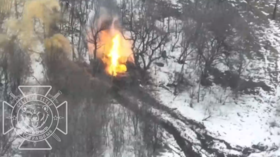Shhh… NASA’s supersonic silent aircraft gets name reflecting long QueSST to make it

After decades in the making, NASA’ s silent supersonic aircraft seems to have reached the stage it deserved a name. The plane is designed to travel over cities faster than the speed of sound and as quietly as a mouse.
The moniker X-59 QueSST was given to the experimental aircraft by the US Air Force, who informed NASA of their choice this week. The name reflects the decades-long journey it took for NASA aeronautics to get the green-light to construct the X-plane.
The X-59 is the product of a $247.5 million contract recently awarded to Lockheed Martin Aeronautics Company by NASA, to build the X-plane that will demonstrate quiet supersonic technologies in straight and level flight over a large area.
The X-plane number designation is a tradition for all important experimental aircraft and rockets, which began in 1947 with the first X-1, a rocket-powered airplane flown by Chuck Yeager who became the first human to fly faster-than-sound.
The ability to fly supersonic, while generating sonic booms that are almost completely silent, has been a plan in the works since the 1960s, when NASA and others modified the nose of fighter jets to prove the boom-reducing theory.
The X-59 is designed so that, when it’s flying supersonic, people on the ground below will hear nothing more than a sonic thump, if anything at all. The aircraft is expected to take to the sky over select towns and cities within National Airspace to test the air (and residents’ hearing) in 2023.
Current regulations, based on aircraft speed, ban supersonic flight over land. The results from these test flights will then be presented to US and international regulators who will be tasked with forming noise level rules to enable new commercial supersonic flights over land.
















